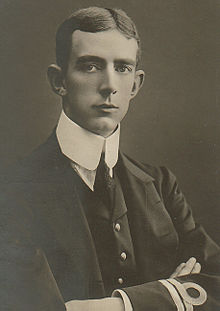Prince Wilhelm, Duke of Södermanland
| Prince Wilhelm | |||||
|---|---|---|---|---|---|
| Duke of Södermanland | |||||

Prince Wilhelm of Sweden and Norway
|
|||||
| Born |
17 June 1884 Tullgarn Palace, Trosa, Sweden |
||||
| Died | 5 June 1965 (aged 80) Stenhammar Palace, Sweden |
||||
| Spouse | Grand Duchess Maria Pavlovna of Russia | ||||
| Issue | Prince Lennart, Duke of Småland | ||||
|
|||||
| House | Bernadotte | ||||
| Father | Gustav V | ||||
| Mother | Victoria of Baden | ||||
| Full name | |
|---|---|
| Carl Wilhelm Ludvig |
Prince Wilhelm of Sweden and Norway, Duke of Södermanland (Carl Wilhelm Ludvig; 17 June 1884 – 5 June 1965) was a Swedish prince. He authored a large number of books (primarily in Swedish) as Prins Wilhelm.
Wilhelm was born at Tullgarn Palace, the second son of King Gustav V of Sweden and his Queen consort Victoria of Baden.
On 3 May 1908, in Tsarskoye Selo, Wilhelm married Grand Duchess Maria Pavlovna of Russia, a daughter of Grand Duke Paul Alexandrovich of Russia by his first wife Princess Alexandra of Greece. The bride was a cousin of the reigning Russian tsar, Nicholas II and of Prince Philip, Duke of Edinburgh. The couple had only one son: Prince Lennart, Duke of Småland and later Count of Wisborg (1909–2004).
The marriage was unhappy. Their son, Lennart, later wrote an autobiography in which he revealed several details of the Swedish royal family. The autobiography tells of how Maria, like her aunt and namesake the duchess of Saxe-Coburg and Gotha, felt that she had married beneath herself in marrying a younger son of the king of Sweden, and this caused problems of ego between the couple. Maria insisted that the servants address her by her correct style Your Imperial and Royal Highness, to the chagrin of her husband, who was merely a Royal Highness. When apprised of the matter, Wilhelm's father King Gustav V had no choice but to acquiesce with his daughter-in-law's wish, which was perfectly valid in law, and order that the imperial style be used invariably for Maria. Nor was this all. Maria also made her husband feel sexually inadequate. In later years, she would tell people that her husband was a homosexual, or at least sexually inadequate. The suggestion of homosexuality was probably a malicious falsehood because Wilhelm later had a lifelong relationship with another woman.
...
Wikipedia
